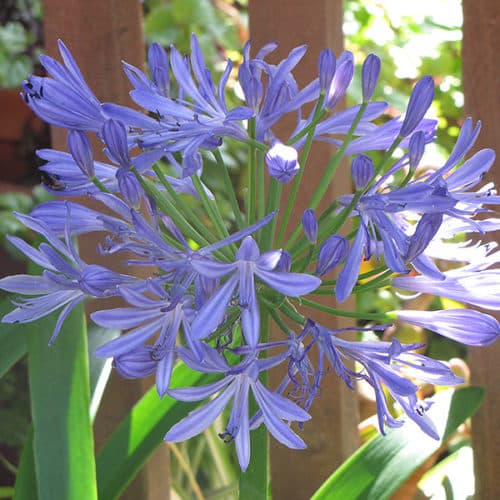Mastering the Art of Agapanthus Care: Crucial Steps for Healthy Growth and Vivid Flowers
In the world of gardening, the cultivation of agapanthus stands as a fulfilling undertaking for those who look for to nurture these stylish blooming plants. From picking the appropriate selection to mastering pruning techniques, the trip towards cultivating thriving agapanthus plants is diverse and holds the essential to unlocking the full possibility of these botanical treasures.

Picking the Right Agapanthus Variety

When choosing the best Agapanthus variety for your yard, think about factors such as environment viability, blossom color, and growth behavior. Agapanthus, generally referred to as Lily of the Nile or African lily, comes in a variety of colors ranging from tones of blue and purple to white. Pick a blossom color that enhances your existing yard palette to produce an unified landscape. In addition, take into consideration the environment in your area to make sure the Agapanthus selection you pick can grow in your specific conditions. Some selections are much more tolerant of cold temperature levels, while others prefer warmer environments. Understanding the growth routine of various Agapanthus ranges is vital for appropriate positioning within your yard. Some selections have a clumping development habit, ideal for borders or containers, while others have an even more dispersing nature, appropriate for ground cover or mass growings. By thoroughly assessing these variables, you can choose the ideal Agapanthus selection to boost the beauty of your garden.
Suitable Planting Problems
Thinking about the optimum ecological needs is crucial for effective Agapanthus cultivation. Agapanthus grows in well-draining dirt with a somewhat acidic to neutral pH degree. When growing, select a location that gets complete sunlight to partial shade. In hotter climates, giving some afternoon color can prevent scorching of the leaves. Agapanthus plants are sensitive to cool temperature levels and ought to be secured from frost throughout winter season.
To ensure healthy growth and vibrant flowers, plant Agapanthus light bulbs at a deepness of regarding 2-4 inches and space them 8-12 inches apart. Mulching around the base of the plants helps keep dampness and suppresses weed development.
Watering and Fertilizing Tips
Preserving proper moisture levels and giving essential nutrients are essential elements in the treatment program for Agapanthus plants. When it comes to watering Agapanthus, it is vital to strike a balance. These plants prefer consistently wet dirt yet are prone to root rot if overwatered.
Feeding Agapanthus is crucial for promoting healthy growth and respected flowers. Apply a imp source well balanced fertilizer, such as a 10-10-10 formula, in the very early spring as brand-new growth arises. Repeat this application every 6-8 weeks throughout the expanding period. Prevent extreme fertilization, as it can lead to lush foliage at the expenditure of blossoms. Always follow the producer's guidelines for appropriate dilution and application techniques. By complying with these watering and feeding ideas, you can guarantee your Agapanthus plants flourish and generate dynamic, lasting blooms.
Pruning Methods for Agapanthus
Trimming Agapanthus plants at the appropriate times and with proper strategies is crucial for maintaining their health and wellness and advertising ideal development and blooming. The ideal time to trim Agapanthus is in late winter or very early springtime before new growth arises. Begin by getting rid of any type of yellowing or dead leaves near the base of the plant. Cut them as short as feasible without harming the arising shoots.
Deadheading invested flowers can likewise redirect the plant's energy into generating even more flowers rather than establishing seeds. If you want to collect seeds for breeding, leave some blossoms to fully grown and dry on the plant.
Keep in mind to utilize clean, sharp tools to make exact cuts and minimize the risk of presenting illness. Agapanthus. Routine pruning will certainly assist keep your Agapanthus looking neat and healthy while ensuring a plentiful display screen of attractive flowers
Taking Care Of Common Parasites and Diseases
After guaranteeing appropriate pruning strategies for Agapanthus, it is important to attend to typical insects and illness that can impact the health and wellness view it now and vitality of these plants. One usual bug that impacts Agapanthus is the Agapanthus gall midge.
One more typical issue is fungal fallen leave spot, which offers as dark lesions on the leaves. To stop fungal conditions, ensure great air blood circulation around the plants, prevent overhanging watering, and eliminate any kind of contaminated fallen leaves quickly. Additionally, Agapanthus plants can experience origin rot if they are planted in badly anchor draining soil. To avoid this, plant Agapanthus in well-draining dirt and prevent overwatering. By being alert and taking timely activity versus illness and insects, you can aid your Agapanthus plants grow and produce vivid blossoms.

Verdict
Finally, grasping the art of agapanthus care entails choosing the appropriate variety, providing perfect growing conditions, appropriate watering and fertilizing, proper trimming techniques, and dealing with usual pests and conditions. By complying with these necessary steps, you can ensure healthy development and lively blossoms for your agapanthus plants. Keep in mind to consistently keep an eye on and preserve your plants to advertise their general well-being and long life.
To ensure healthy development and lively flowers, plant Agapanthus bulbs at a deepness of regarding 2-4 inches and room them 8-12 inches apart. By following these watering and feeding pointers, you can guarantee your Agapanthus plants prosper and produce dynamic, durable flowers.
One usual pest that affects Agapanthus is the Agapanthus gall midget. Furthermore, Agapanthus plants can suffer from root rot if they are planted in inadequately draining soil. By following these vital steps, you can make certain healthy development and vibrant blooms for your agapanthus plants.